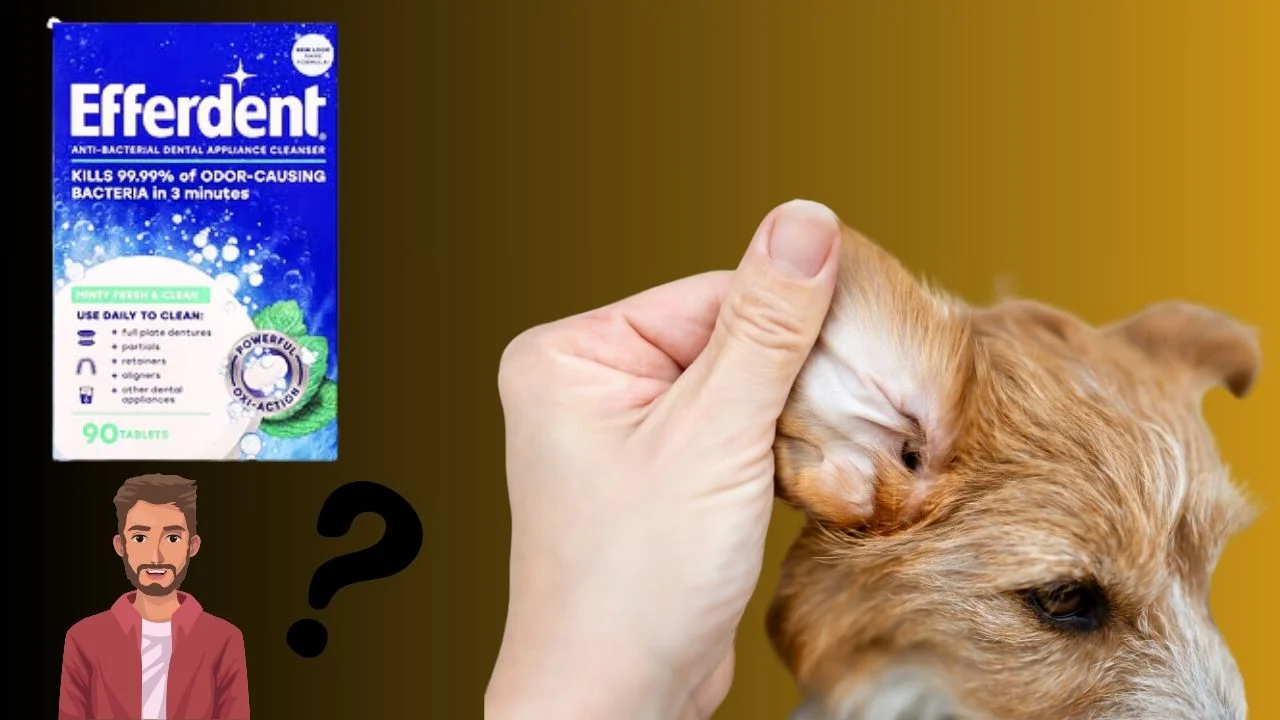Hey buddy, can I use antibacterial denture cleanser to clean dogs’ ears sounds like a quick fix, but it’s actually a bad idea. Your dog’s ears are 4 times more sensitive than human skin, and denture cleansers contain harsh chemicals. Using them can cause irritation, infections, or even long-term damage. Instead, check out Dog Ear Mites vs Ear Wax to understand the right way to care for your pup’s ears. Let’s break down why it’s unsafe and what you should use instead.
Quick Navigation
Can I use antibacterial denture cleanser to clean my dog’s ears?
No, using antibacterial denture cleanser on your dog’s ears is not safe. These cleansers contain harsh chemicals like hydrogen peroxide and sodium hypochlorite, which can irritate your dog’s sensitive ear canal, leading to dryness, discomfort, or infections.
Dog ears are 4 times more delicate than human skin, and denture cleansers are made for hard surfaces, not soft tissues. If you’re wondering, “Is denture cleanser safe for dogs’ ears?” the answer is no these products contain harsh chemicals that can cause irritation and infections. Instead, use vet-approved ear cleaning solutions or gentle natural remedies. Also, check out the Best hip and joint supplements for pets for overall pet health.
Why It’s Unsafe for Dogs
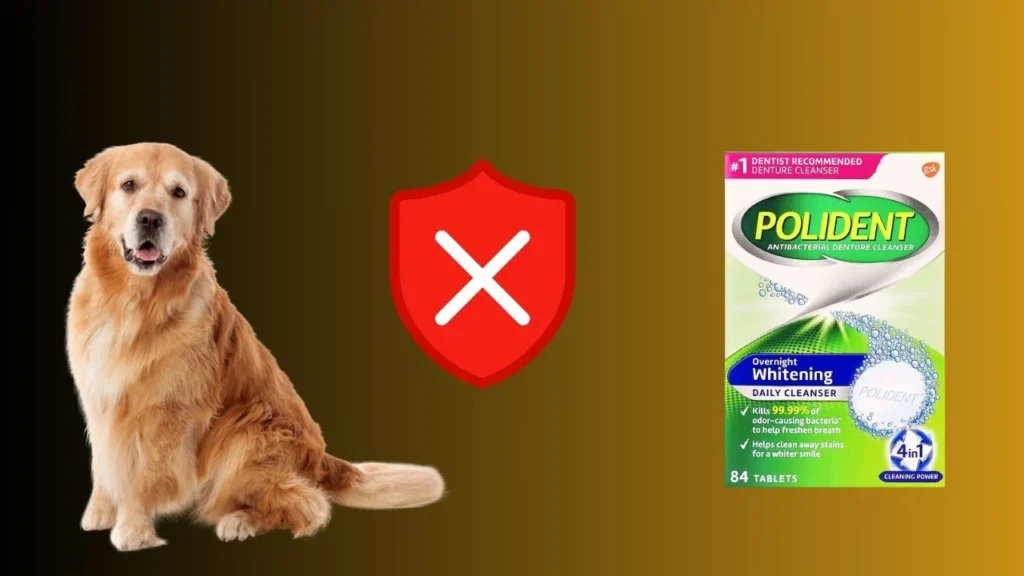

Denture Cleansers Are Made for Hard Surfaces, Not Ears
Alright, let’s get real can I use antibacterial denture cleanser to clean dogs ears? Denture cleansers are made for fake teeth, not your dog’s ears. They’re designed to remove 99% of bacteria and plaque from hard surfaces like dentures, but your dog’s ears? Those are soft, sensitive, and completely different. Using denture cleaner on them is like scrubbing your face with a toilet cleaner way too harsh and totally unnecessary.
Harsh Chemicals Can Mess Up Your Dog’s Ears
Most denture cleansers contain some pretty strong stuff that your dog’s ears just aren’t built for. Hydrogen peroxide (3% to 10%) can cause burning and dryness, and once the ear canal is dry, infections become 3x more likely. Baking soda (pH 8-9) can throw off the natural balance inside the ear, making it easier for bacteria to grow.
Some brands even have chlorine-based chemicals, and trust me, you don’t want that soaking into your pup’s skin. The best way to clean dog ears safely is by using vet-approved solutions made specifically for pets, not harsh denture cleansers. Also, check out the Top dog joint health supplements to support your dog’s mobility and overall well-being.
Residue Stays Behind and Causes Problems
Here’s the thing: denture cleansers don’t just disappear. Tiny leftover particles can stick around in your dog’s ear for up to 24 hours. That means more itching, more irritation, and a bigger chance of infections. A dried-out ear canal is 5x more likely to develop problems than a healthy one. Plus, if an infection does start, it can take 7 to 14 days to heal, and no one wants their dog to suffer that long. Also, learn more about canine health concerns and factors contributing to younger deaths in Golden Retrievers.
Infections and Pain Are a Real Risk
Your dog’s ears are 4 times more sensitive than yours. If you use something too strong, it strips away natural oils, and bacteria or yeast can multiply within 48 hours. That means redness, swelling, and constant scratching.
If your dog is shaking its head more than 10 times an hour or rubbing against furniture non-stop, it’s a clear sign that something’s wrong. Some people consider using denture cleaner for pet ear infections, but this can do more harm than good. Instead, stick to safe, vet-approved solutions to keep your pup’s ears healthy and irritation-free.
Safe Alternatives for Cleaning Dog Ears
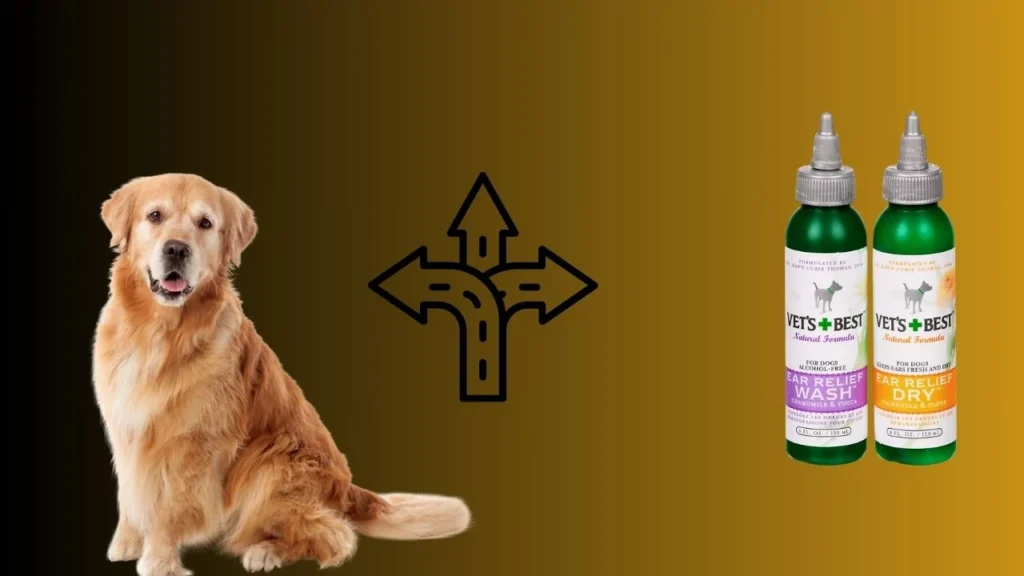

Alright buddy, now that we know denture cleanser is not the way to go, let’s talk about what actually works. You want to clean your dog’s ears safely, without causing irritation or infections. Here are 3 trusted methods that work best.
1. Vet-Approved Ear Cleaning Solutions (Best Choice)
The safest and most effective way to clean your dog’s ears is with a vet-approved ear cleaner. These solutions are specially made for dogs, meaning they have gentle ingredients that won’t harm their delicate ears.
What to look for:
- Alcohol-free formula – Prevents dryness and irritation.
- pH-balanced for dogs – Keeps ear health in check.
- Mild antibacterial properties – Helps fight off bacteria buildup.
How to use it:
- Pour a few drops into your dog’s ear.
- Gently massage the base of the ear for 30-60 seconds.
- Use a cotton ball or gauze pad to wipe away loosened dirt.
Using this method every 1-2 weeks keeps the ears clean without overdoing it.
2. DIY Home Remedies (Use with Caution)
Some natural options can work, but they must be used carefully. Not every home remedy is safe for dogs, so always check with your vet first.
- Apple Cider Vinegar (Diluted 50/50 with Water) – Helps break down wax and dirt but shouldn’t be used if your dog has scratches or sores inside the ear.
- Coconut Oil (Warm & Liquid Form) – Has mild antibacterial properties and can help with irritation, but too much can leave greasy buildup.
If you decide to go the DIY route, make sure you’re using the right amount and never pour anything directly into the ear canal without guidance.
3. Proper Ear Cleaning Tools (No Cotton Swabs!)
Cleaning is not just about the solution you use; the right tools matter too.
Avoid:
- Cotton swabs (Q-tips) – These push dirt further inside and can cause damage.
Use instead:
- Cotton balls or gauze pads – Soft and safe for wiping.
- Syringe or dropper – Helps apply liquid evenly.
- Soft cloth or towel – Great for drying after cleaning.
How to Clean Dog Ears the Right Way
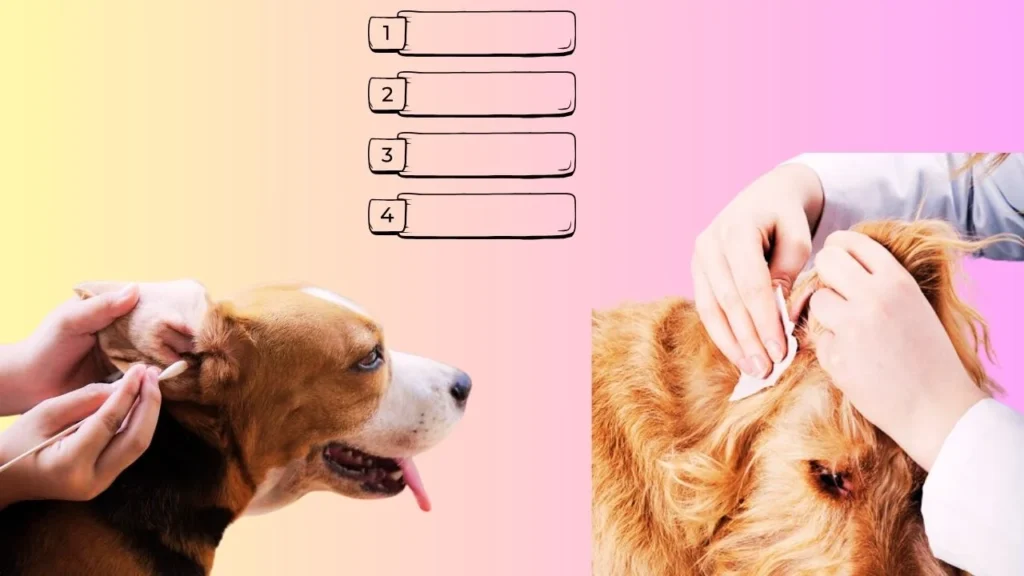

Alright, buddy, let’s get into it. Cleaning your dog’s ears isn’t difficult, but you need to do it the right way to avoid irritation or infections. A dog’s ears are much more sensitive than ours, so a little extra care goes a long way.
You might be wondering, Can I Use Antibacterial Denture Cleanser to Clean Dogs Ears? While it may seem like a quick fix, it’s not the safest option. Using vet-approved dog ear cleaning solutions is the best way to remove dirt and wax without causing harm. Follow these steps to keep those ears clean and healthy.
Step 1: Check If Your Dog Even Needs an Ear Cleaning
Not all dogs need frequent ear cleaning. Over-cleaning can actually cause irritation and do more harm than good. Here’s how to tell if it’s time to clean:
- Strong, bad smell coming from the ears.
- Visible buildup of brown or yellow wax.
- Frequent scratching or rubbing of the ears.
- Head shaking more than usual.
Step 2: Gather Your Cleaning Supplies
Before you start, make sure you have everything ready. The last thing you want is to stop halfway and grab missing items.
You’ll need:
- A vet-approved ear cleaning solution (avoid alcohol or hydrogen peroxide).
- Cotton balls or gauze (never use Q-tips—they push wax deeper).
- A towel (some dogs might shake their heads and splash the solution).
- Treats (reward them for sitting still).
Step 3: Keep Your Dog Calm
Some dogs sit quietly, while others act like they’re about to be sent to the vet. If your dog is nervous, try this:
- Give them a treat before starting.
- Talk to them in a calm voice to reassure them.
- Choose a quiet spot where they feel comfortable.
Step 4: The Right Way to Clean Dog Ears
Now, let’s do this the proper way. Go slow, be gentle, and follow these steps:
- Lift the ear flap – Hold it up gently so you can see inside.
- Apply the cleaning solution – Squirt a few drops into the ear canal (follow the bottle’s instructions).
- Massage the base of the ear – Gently rub for 30 seconds to loosen wax and dirt.
- Let your dog shake it out – Step back and let them shake their head. This helps remove loosened debris.
- Wipe away excess dirt and wax – Use a cotton ball or gauze to clean the outer ear (don’t go deep).
- Repeat on the other ear if needed.
Preventing Ear Problems
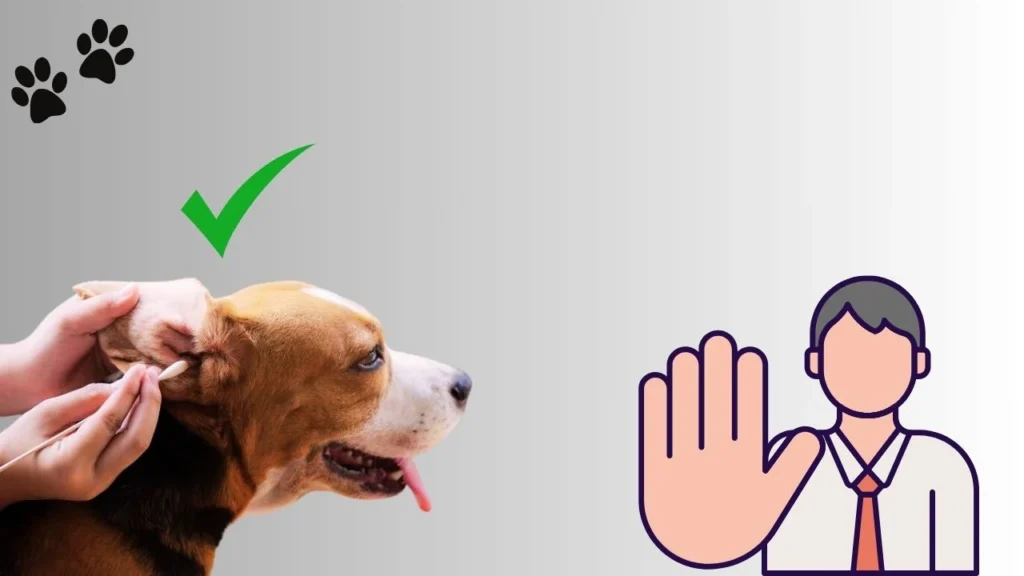

Preventing Ear Infections & Maintaining Good Ear Health
Alright, buddy, let’s talk about keeping your dog’s ears clean and healthy so you don’t have to deal with infections in the first place. Nobody likes a surprise vet bill, right? Here are 4 simple ways to prevent ear problems before they start. Also, make sure your pup gets the right nutrition for overall health by reading the Ultimate Large Breed Dog Food Guide 2023.
Check Your Dog’s Ears Weekly
Dogs can’t tell you when something’s wrong, so you’ve got to be their eyes (and ears!). Take 5 minutes each week to check for redness, swelling, or any funky smells. If their ears stink or look inflamed, it’s time to call the vet.
Keep Ears Dry, Especially After Baths
Moisture is a playground for bacteria and yeast, and that’s the last thing you want in your pup’s ears. After a bath or swim, gently dry their ears with a soft towel. If your dog has floppy ears, lift them up and let the air circulate for a bit.
Trim the Hair Around Their Ears
If your dog has long or thick hair around their ears, trimming it can help prevent dirt and wax buildup. For breeds like Cocker Spaniels or Poodles, keeping the ear area neat can reduce the risk of infections by 30%! Just be careful use pet-safe grooming scissors or ask a pro groomer.
Feed Them a Healthy Diet
Believe it or not, your dog’s diet affects their ear health. A well-balanced diet rich in Omega-3 fatty acids helps reduce inflammation and keeps their skin (including their ears) healthy. If your pup gets frequent ear infections, your vet might suggest a diet change to avoid food allergies.
Common Myths About Dog Ear Cleaning
🚫 Myth #1: “If my dog’s ears look clean, I don’t need to check them.”
Nope! Just because they look fine doesn’t mean there isn’t a problem brewing inside. Some infections don’t show obvious signs at first, so regular checks are a must.
🚫 Myth #2: “Cotton swabs are safe for cleaning dog ears.”
Big mistake! Using Q-tips can push debris further down into the ear canal, making things worse. Stick to vet-approved ear cleaners and cotton pads instead.
🚫 Myth #3: “Denture cleanser is a cheap alternative to dog ear cleaners.”
This is a hard NO. Denture cleansers contain strong chemicals that can burn, irritate, or even damage your dog’s ear canal. A proper ear-cleaning solution for pets costs around $10–$20 way cheaper than a vet visit for an ear infection!
🚫 Myth #4: “Frequent ear cleaning is better.”
More isn’t always better! Over-cleaning can strip the ear’s natural protective oils and cause irritation. Most dogs only need their ears cleaned once every 2–4 weeks, unless your vet says otherwise.
Key Takeaways
- Denture cleansers are unsafe for dog ears – They contain harsh chemicals that can cause irritation, infections, and serious discomfort.
- Use pet-safe alternatives – Stick to vet-approved ear cleaners and gentle cleaning techniques to keep your dog’s ears healthy.
- Prevention is key – Regular ear checks (every 2 weeks), keeping ears dry, and trimming hair around the ears help prevent infections before they start.
Wrap Up
Yes, handsome, let’s keep it simple Can I Use Antibacterial Denture Cleanser to Clean Dogs Ears? No, it’s not safe. These cleansers have strong chemicals that can cause pain, irritation, and infections. Instead, use vet-approved ear cleaners and clean gently.
Safe alternatives for cleaning dog ears include pet-friendly ear solutions that won’t harm your pup. Check your dog’s ears every 2 weeks, keep them dry, and trim extra hair to stop problems before they start. A little care now can save you big vet bills later. Do it the right way, and your pup will stay happy and healthy. Clean ears, happy dog!

